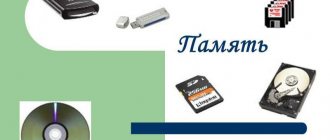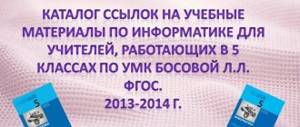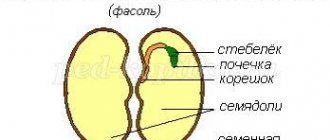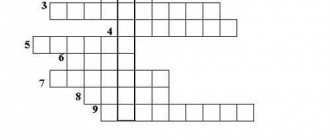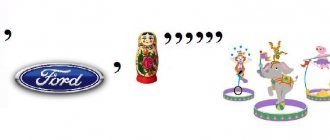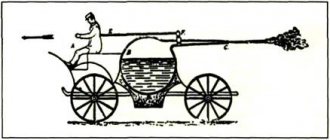Lesson summary on computer science in 7th grade “Information and its properties”
LESSON ON THE TOPIC
"Information and its properties."
in the 7th grade.
(7th grade textbook. Authors L.L. Bosova, A.Yu. Bosova. -M: BINOM. Knowledge Laboratory, 2013)
Date "__" __________ 20__ Teacher Leontyeva A.M.
The purpose of the lesson:
students’ mastery of the concepts of information, types and properties of information.
Lesson objectives:
educational:
• develop students' concept of information;
• introduce different types of information according to its purpose, nature, methods of perception and its properties;
developing:
• develop thinking (ability to compare, analyze, generalize);
educational:
• cultivate a respectful attitude towards the opinions of others.
Lesson type:
combined.
Teaching method:
explanatory and illustrative.
Equipment:
board, computer, projector, computer presentation
Forms of work in the lesson:
frontal (conversation), problem solving.
Lesson plan:
- Organizing time.
- Updating knowledge.
- Learning new material.
- Consolidation of new material.
- Summing up the lesson.
- Homework.
During the classes
1. Organizational moment.
The teacher welcomes students and notes those who are absent in the journal.
2. Updating knowledge
Let's try to answer the following questions:
What is information?
What kind of information is there?
- Learning new material.
(slide 1)
In this lesson we will learn what information is and consider its properties.
Let's write down the topic of the lesson in our notebooks - “Information and its properties”
(slide 2)
Information is a very broad concept with many interpretations.
Information is brought to us by other people, all kinds of objects and phenomena. Correct information can be obtained from various sources - TV, books, computer, radio, seen on the street, etc. Each material object with which changes occur becomes a source of information either about the environment or about the processes occurring in this object. We receive this information in the form of signals - sound, light, thermal, electrical, etc. The person himself is also a source of information.
Let's write down the definition:
Information for a person
— this is the content of signals (messages) perceived by a person directly or with the help of special devices, expanding his knowledge about the world around him and the processes occurring in it.
(slide 3)
Signals can be continuous or discrete.
Continuous signal
takes an infinite number of values from a certain range. There are no breaks between the values it takes
Examples of continuous signals include music, human speech, images
Discrete signal
takes a finite number of values. All values of a discrete signal can be numbered with integers.
Examples of discrete signals include readings from a mechanical or electronic watch, texts in books, readings from digital measuring instruments, and a traffic light signal.
An example of how a continuous signal (human speech) is converted into a discrete signal when transmitted using modern communications.
The blue line (continuous) is live speech, the circles are individual values of sound amplitude taken after a certain (uniform) period of time. This way we can explain why the voice we hear in the telephone handset (discrete) differs from a live voice (continuous).
(slide 4)
A person receives information into the brain through his senses. According to the way a person perceives information, it can be divided into the following types:
visual
(we perceive letters, numbers, pictures, distinguish color, shape, size and arrangement of objects);
auditory
(sound information is perceived - speech, music, sound signals, noise);
gustatory
(you can get information about what the item is - bitter, sour, sweet, salty);
olfactory
(people perceive smells);
tactile
(a person receives information about the temperature of an object - warm or cold, about the quality of its surface - smooth or rough, etc.).
(slide 5)
Any substance can be characterized by its properties, for example, solid, light, white, etc. Information also has properties.
Information properties:
Utility
– the importance or uselessness of this information for a specific person or a specific task that will help in solving it.
For example, information is important to you when
Relevance
– timely receipt. Information is relevant if it is important and significant for the present time.
Credibility
(truthfulness) – a reflection of the true situation. Incorrect information is unreliable and can be: in the case of deliberate distortion (disinformation); as a result of interference “interference in communication lines due to bad weather”); When downplaying or exaggerating the significance of a real event (rumours, advertising).
Objectivity
– dependence on someone else’s judgment or not. Information that depends on someone else's judgment is called subjective.
Completeness
– sufficiency for understanding the situation and making a decision. Making decisions based on incomplete information can lead to mistakes.
Understandability
(recognizability) – information becomes accessible only if it is possible to recognize the signs and signals through which it is transmitted. You will not be able to use information if it is expressed in a language you do not know.
Immateriality
– information is intangible, but can only manifest itself through material processes and signals.
(slide 6)
4. Consolidation of new material
Please answer the questions:
Questions from the textbook (pages 11-12)
- What is information for a person? List the sources from which you obtain information.
- Give examples of continuous and discrete signals.
- List the main types of information according to the way a person perceives it.
(visual, auditory, gustatory, olfactory, tactile)
- What properties does information have? (objectivity, reliability, completeness, relevance, usefulness, understandability, intangibility)
- Choose the correct answer. (in italics)
- If you are going to spend a day off in nature, then timely information for you will be:
- weather information on the same day last year;
- weekend weather forecast
- The Volga flows into the Caspian Sea - this is:
- reliable information;
- false information.
- About the rules of the road for every car driver:
- must have complete information;
- may have incomplete information.
(slide 7)
- About the engine structure every car driver:
- must have complete information;
- may have incomplete information.
- Information on how to make fire using improvised means will be most useful to you:
- if you find yourself on a desert island;
- in our daily life.
- Rumors, fabrications, untested hypotheses are:
- reliable information;
- false information.
5. Summing up the lesson.
The teacher grades students by commenting on them.
6. Homework.
(slide 
§ 1.1 (p. 7-11) Tasks 8, 9 (p. 12)
(Textbook for grade 7. Authors L. L. Bosova, A. Yu. Bosova. – M: BINOM. Knowledge Laboratory, 2013)
Lesson summary on computer science for 7th grade with presentation. Text formatting
Lesson summary in computer science, grade 7
Author: Samarin Alexander Alexandrovich, computer science teacher at Savinskaya Secondary School, Savino village, Ivanovo region. Topic: “Text Formatting.” Description of the material: the lesson notes on computer science will be useful to computer science teachers implementing general education programs in 7 grades, working according to the textbook by L.L. Bosova. "Computer science". During the lesson, students gain knowledge about formatting text documents on a computer, as well as skills in working in Microsoft Word. Goal: to create conditions for children to acquire knowledge of formatting text documents on a computer and skills in working in Microsoft Word. Objectives: - consolidate knowledge on the topic “creating text documents on a computer”; - develop knowledge about formatting text documents on a computer; — develop skills in working in Microsoft Word. Planned results: Subject:
- form ideas about entering and editing texts as stages of creating text documents;
- develop ideas about direct and style formatting, various text formats. Meta-subject:
- to develop skills in using information and communication technologies to create text documents;
— develop skills in rational use of available tools. Personal:
- to form an understanding of the social and general cultural role of skilled keyboard writing skills in the life of a modern person.
Lesson progress:
I. Organizational moment and updating of knowledge Teacher: “Hello, guys. Let’s remember what we covered in the last lesson.” Children: “We got acquainted with programs for creating text documents on a computer.” Teacher: “What programs are these?” Children: “Notepad, Writer, Word.” Teacher: “What is used to enter text on a computer?” Children: “Text input on a computer is done using the keyboard.” Teacher: “What else did you learn in the last lesson?” Children: “How can you edit text, check spelling in a word processor, what is a fragment and how can it be edited.” Teacher: “Guys, let’s look at the screen.” Task 1 is projected onto the screen - Find the correspondence between keys and commands.
Children complete the task.
Task 2
- What do the following key combinations do?
Children complete the task. Teacher: “Guys, how else can you view text on the screen? Children: “Using the stripes located on the right and bottom of the document window.” Teacher: “Guys, when editing you can work not only with individual characters, but also with entire fragments of text. What is a fragment? Children: “A fragment is an arbitrary number of text characters following one after another: one or more characters, a word, line, sentence, paragraph, or even the entire document.” Teacher: “How can you highlight a fragment?” Children: “To select a fragment, you need to place the mouse pointer at the beginning of the desired fragment and, holding the left mouse button pressed, drag the pointer to its end.” Teacher: “What can you do with the selected fragment?” Children: “Delete, cut, copy, paste.” Teacher: “The slide lists sentences where spaces between words and punctuation marks are placed correctly?” Task 3 is projected onto the screen - Where are the spaces between words and punctuation marks correctly placed?
Children complete the task.
II. Studying new material Teacher: “Guys, what else do you think can be done with the text?” Children: “Change font sizes, colors, fonts, etc.” Teacher: “Yes, that’s right. What word can be used to describe the listed actions?” Children: "Formatting." Teacher: “That's right. This is the topic of our lesson today. What is formatting? Formatting is the process of arranging text. The purpose of formatting is to make the finished document simple and enjoyable to read.” The formatting definition and its purpose are projected onto the screen. Teacher: “When preparing documents, the user applies formatting commands to individual elements. There are two ways to format texts: direct and style formatting. Methods for formatting text are projected onto the screen. Direct formatting is applied to arbitrary character fragments (individual characters, words, lines, sentences) and paragraphs. What is a symbol? A symbol is the minimum graphic unit of text. Basic properties of a symbol: font, font size, style and color. The definition of direct formatting, the character, and its basic properties are projected onto the screen. A font is an image of symbols used for writing, made in the same style. Thousands of different fonts are available. All of them can be divided into four main groups: 1) Serif fonts, 2) Serif fonts, 3) Calligraphic (handwritten) fonts, 4) Decorative fonts.” The definition of fonts, its types with examples are projected onto the screen. Teacher: “Font size (point) is the height of the font, measured from the bottom edge of the lowest letter to the top edge of the tallest letter. Point size is measured in points. One point is equal to 1/72 of an inch (approximately 0.35 mm).” A size definition and a picture are projected onto the screen, showing where you can change the font size on the toolbar. Teacher: “Character style: normal, bold, italic, underlined, strikethrough, outline, superscript, subscript. Symbol styles with examples and a picture are projected onto the screen, which shows where you can change the symbol style on the toolbar. Symbol color – the color of the visible part of the symbol (picture).” A picture is projected onto the screen showing where you can change the color of the symbol on the toolbar. Teacher: “Next, let’s look at formatting paragraphs. A paragraph is the portion of a document between two adjacent non-printable end-of-paragraph control characters. The process of entering a paragraph ends by pressing the Enter key. Basic properties of a paragraph: alignment, first line indent, line spacing, left and right indents, spaces before and after. Paragraph alignment - the location of the paragraph relative to the side borders of the page (left, centered, right, justified). Left (right) indentation – the distance from the edge of the page to the left (and, accordingly, right) border of the paragraph. First line indent – indent before the paragraph, red line. The interval before and after sets the distance between adjacent paragraphs, respectively, above, below, in points. Line spacing determines the distance between adjacent lines within a paragraph. The definition of a paragraph, its main properties, as well as a picture where these properties can be changed are projected onto the screen. Small documents can be formatted using direct formatting. When working with large texts, style formatting is usually used. The point is that structural elements that carry the same functional load are assigned a certain formatting style - a set of formatting parameters (font, its style, size, and so on).” The meaning of the style formatting is projected onto the screen. Teacher: “When preparing a text document intended for printing, special attention should be paid to its location on a sheet of paper. The user can select the orientation of the sheet of paper (portrait, landscape), paper size, and set certain page parameters (margins, headers and footers, binding position).” The “Page Options” panel is projected onto the screen. Teacher: “After formatting the text, you need to save it in a certain format. The most common file formats in which text documents are saved are: - TXT - saves text without formatting, only end-of-paragraph control characters are inserted into the text. - DOC - native document format of Microsoft Word, - ODT - proprietary document format of OpenOffice.org Writer, - RTF - a universal format that preserves all formatting, - HTML - a format used for storing web pages, - PDF - a format intended for presentation in electronic form of printed documents." The file formats in which text documents are saved are projected onto the screen. III. Physical education lesson Teacher: “Now let’s rest a little. Guys, sit comfortably on a chair, relax, straighten your shoulders, arch your back, stretch, turn your head, “dangle your legs.” Now, without turning your head, look to the right, left, up, down. Now watch the movements of my hand.” The teacher moves his hand in different directions. IV. Practical work Teacher: “Guys, now we will consolidate the acquired knowledge with practical work on the computer.” Children are given sheets of paper with the task: Guys, type the text in Microsoft Word: Requirements for the presentation of the abstract The abstract must be completed on one side of sheets of white A4 paper. Page margin dimensions: right – 30 mm (for teacher comments); top, bottom, left – 20 mm. The first line indent is 12 mm, the same throughout the text. Line spacing is one and a half. Paragraph alignment is justified. The main text font is TimesNewRoman. Point size – 14. Font color – black. Tasks: 1) Select the title of the text and replace it with bold; 2) Edit the text as stated in the requirements for the abstract; 3) Below, after 1 empty line, indicate your last name and first name. Children do the task on the computer. V. Lesson summary and reflection Teacher: “Guys, what did you learn new today? What was hard for you? What difficulties did you encounter while doing practical work? The children answer. Teacher: “Thank you for your work in class.
Goodbye". Presentation on the topic: Text Formatting
We recommend watching:
Integrated interdisciplinary lesson in computer science + English, grades 7-8. Abstract Information security on the Internet Abstract of a computer science lesson in 7th grade with presentation. Creating animated images in MS Power Summary of an integrated lesson in computer science and ICT with presentation “Creating a simple database”
Similar articles:
Summary of a computer science lesson on the topic “Running and long-term computer memory”, grade 7
